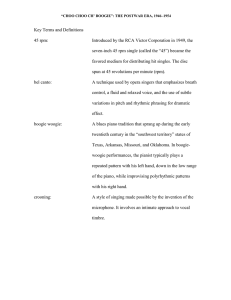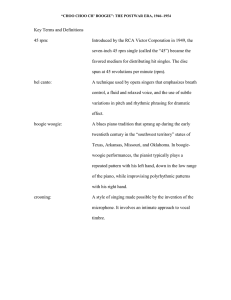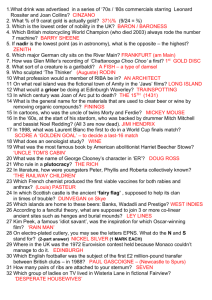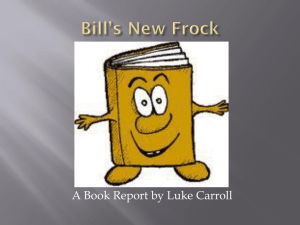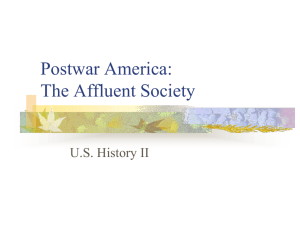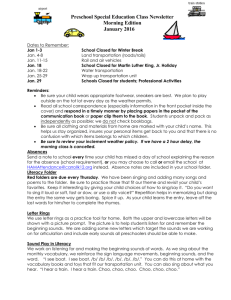Important Names and Brie#F9.doc
advertisement
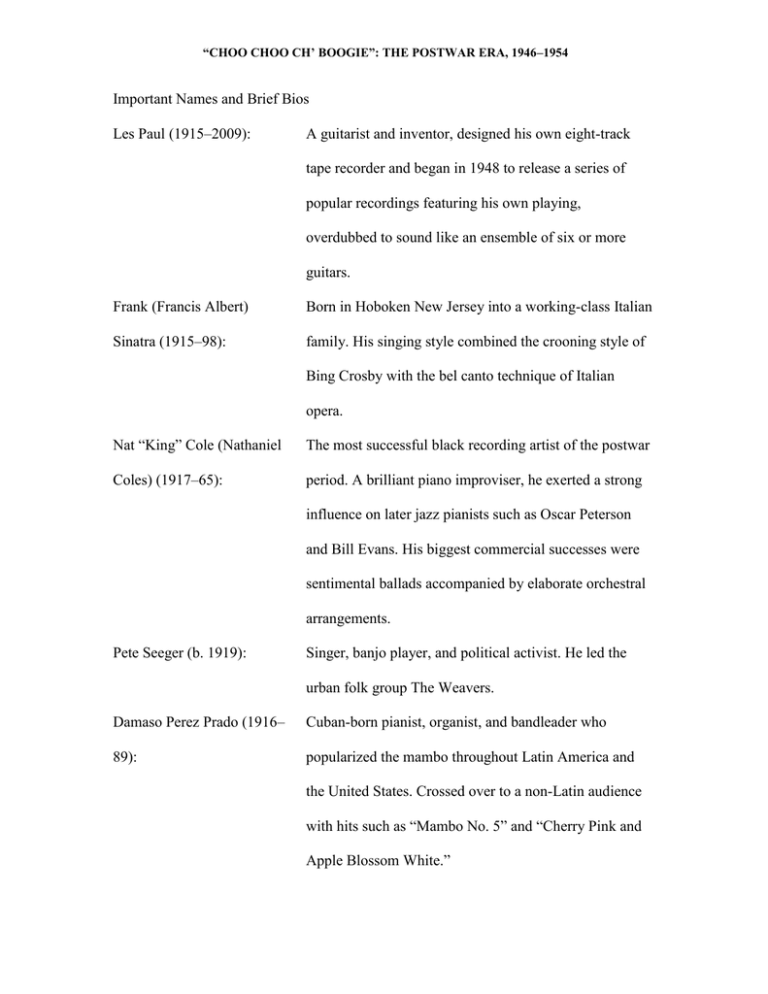
“CHOO CHOO CH’ BOOGIE”: THE POSTWAR ERA, 1946–1954 Important Names and Brief Bios Les Paul (1915–2009): A guitarist and inventor, designed his own eight-track tape recorder and began in 1948 to release a series of popular recordings featuring his own playing, overdubbed to sound like an ensemble of six or more guitars. Frank (Francis Albert) Born in Hoboken New Jersey into a working-class Italian Sinatra (1915–98): family. His singing style combined the crooning style of Bing Crosby with the bel canto technique of Italian opera. Nat “King” Cole (Nathaniel The most successful black recording artist of the postwar Coles) (1917–65): period. A brilliant piano improviser, he exerted a strong influence on later jazz pianists such as Oscar Peterson and Bill Evans. His biggest commercial successes were sentimental ballads accompanied by elaborate orchestral arrangements. Pete Seeger (b. 1919): Singer, banjo player, and political activist. He led the urban folk group The Weavers. Damaso Perez Prado (1916– Cuban-born pianist, organist, and bandleader who 89): popularized the mambo throughout Latin America and the United States. Crossed over to a non-Latin audience with hits such as “Mambo No. 5” and “Cherry Pink and Apple Blossom White.” “CHOO CHOO CH’ BOOGIE”: THE POSTWAR ERA, 1946–1954 Louis Jordan (1908–75): Arkansas-born saxophone player and singer who began making recordings for Decca Records in 1939. He led the most successful and influential jump band, the Tympany Five. Jordan was tremendously popular with black listeners and was able to build an extensive white audience during and after World War II. Milt Gabler (b. 1911): White record producer who worked with Louis Jordan in the 1940s and later produced rock ‘n’ roll hits by Bill Haley and the Comets. Leroy Carr (1905–35): Born in Indianapolis, Indiana, developed a smooth, laidback approach to blues singing that contrasted sharply with rough-edged rural blues. He attracted a national black audience. Scrapper Blackwell (1903– Along with pianist Leroy Carr, made several race records 62): in the late 1920s and 1930s and established the roots for the blues crooner style. Cecil Gant (1913–51): A blues crooner who had a hit with a love song called “I Wonder,” sung in a gentle, slightly nasal, bluesy style, and accompanied only by his own piano playing. Charles Brown (1922–99): The most successful blues crooner of the late 1940s and early 1950s. Brown was a soft-spoken, Texas-born pianist who studied classical piano as a child and graduated from college in 1942 at the age of twenty. “CHOO CHOO CH’ BOOGIE”: THE POSTWAR ERA, 1946–1954 Muddy Waters (McKinley Often called the “Father of Chicago Blues,” he was Morganfield) (1915–83): discovered by Allan Lomax in 1941. Waters sang in a country style and was a charismatic performer. He played both acoustic and electric slide guitar and was the single greatest influence on the British blues boom. Willie Dixon (1915–92): Chess Records’s house songwriter, bass player, producer, and arranger. Clyde McPhatter (1932–72): A gospel singer from North Carolina and the son of a Baptist preacher and a church organist. The lead singer for the Dominoes. His highly inflected vocal style can be heard on the Dominoes’ hit record “Have Mercy Baby.” Ruth Brown (b. 1928): Also known as “Miss Rhythm,” born in Virginia. and began her professional career at the age of sixteen. In 1949, Brown signed with the new independent label Atlantic Records. Chart figures suggest that Ruth Brown was the most popular black female vocalist in America between 1951 and 1954. Big Mama Thornton (1926– Born in Montgomery, Alabama, the daughter of a Baptist 84): minister. Thornton began her professional career as a singer, drummer, harmonica player, and comic on the black vaudeville circuit and later settled in Houston, Texas, working as a singer in black nightclubs. Her imposing physique and sometimes malevolent “CHOO CHOO CH’ BOOGIE”: THE POSTWAR ERA, 1946–1954 personality helped ensure her survival in the rough-andtumble world of con artists and gangsters. Johnnie Ray (1927–90): Partially deaf since childhood, rose nevertheless to become one of the biggest international pop stars of the early 1950s. Crowned the “Prince of Wails” and parodied as the “Guy with the Rubber Face and the Squirt Gun Eyes,” Ray created an idiosyncratic style based partly in African American modes of performance, and in so doing paved the way for the rock ’n’ roll stars of the later 1950s. Patti Page (b. 1927): Sold more records than any other female singer of the early 1950s. Page had success with love songs (“All My Love,” Number One pop in 1950) and novelties like “The Doggie in the Window” (Number One pop in 1953), but her biggest hit was a recording of the “Tennessee Waltz.” Eddy Arnold (b. 1918): The most popular country crooner. Arnold not only dominated the country charts from 1947 to 1954 but also scored eleven Top 40 hits on the pop charts. Ernest Tubb (1914–84): Began his career in the 1930s as a disciple of Jimmie Rodgers. By the 1940s, Tubb had developed into one of the first honky-tonk performers. He was one of the first musicians to move toward a harder-edged country sound and to switch to amplified instruments, and he wrote “CHOO CHOO CH’ BOOGIE”: THE POSTWAR ERA, 1946–1954 some of the classic songs in the honky-tonk genre. Bill Monroe (1911–97): Born in Kentucky, started playing music at a young age and was influenced by his uncle (a country fiddler) and by a black musician and railroad worker named Arnold Schulz. In 1938, Monroe started the Blue Grass Boys, and the following year he joined the cast of the Grand Ole Opry. Hank Thompson (b. 1925): A native of Waco, Texas, created a popular variation of honky-tonk music by mixing it with elements of western swing. Kitty Wells (b. 1918): Born in Nashville, Tennessee, as Muriel Dearson; married the popular country entertainer Johnny Wright and began appearing with him on the radio in 1938. Her stage name was adopted from an old southern parlor song, “Sweet Kitty Wells.” Hank Williams (1923–53): The most significant single figure to emerge in country music during the immediate post–World War II period. Williams wrote and sang many songs in the course of his brief career that were enormously popular with country audiences at the time; between 1947 and 1953, he amassed an astounding thirty-six Top 10 records on the country charts, including such Number One hits as “Lovesick Blues,” “Cold, Cold Heart,” “Jambalaya (on “CHOO CHOO CH’ BOOGIE”: THE POSTWAR ERA, 1946–1954 the Bayou),” and “Your Cheatin’ Heart.”
